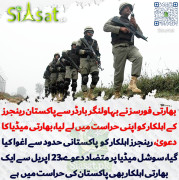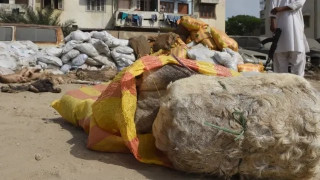amir_ali
Chief Minister (5k+ posts)
The United States has announced that Bashar al-Assad's regime had used chemical weapons against its own people, crossing a "red line" laid out by President Barack Obama and constituting a "game changer" for US policy on Syria.
10:17PM BST 13 Jun 2013
However, the officials said the administration has not determined how it will respond.
In a statement, the White House said: "The President has been clear that the use of chemical weapons – or the transfer of chemical weapons to terrorist groups – is a red line for the United States, as there has long been an established norm within the international community against the use of chemical weapons.
"Following on the credible evidence that the regime has used chemical weapons against the Syrian people, the President has augmented the provision of non-lethal assistance to the civilian opposition, and also authorised the expansion of our assistance to the Supreme Military Council (SMC), and we will be consulting with Congress on these matters in the coming weeks."
Mr Obama has said repeatedly that the use of chemical weapons would cross a "red line" and constitute a "game changer" for US policy on Syria, which until now has focused entirely on providing the opposition with non-lethal assistance and humanitarian aid.
Congress was also being notified of the chemical weapons determination on Thursday in classified documents sent to Capitol Hill, the officials said. The finding was aided by evidence sent to the United States by France, which along with Britain, announced last week that they had determined that Assad's government had used chemical weapons in the two-year conflict. The US confirmed that up to 150 people had been killed in Syria by chemical weapons.
http://www.telegraph.co.uk/news/wor...-says-Assad-regime-used-chemical-weapons.html
=====================================================
http://www.reuters.com/article/2013/06/13/us-syria-crisis-chemical-idUSBRE95C1CD20130613
http://bigstory.ap.org/article/un-more-evidence-needed-syria-chemical-weapons
====================================================
Syria's chemical weapons stockpile and human impact

The footage of an alleged chemical weapon attack was posted on YouTube
The size and location of Syria's chemical weapons stockpile has been the subject of speculation for many years.
While Syria's possession of chemical weapons has never been in any doubt, there is no reliable information on how it obtained and developed its arsenal.
The country has not signed the Chemical Weapons Convention (CWC) nor ratified the Biological and Toxin Weapons Convention (BTWC), so it has never made a formal declaration of its stock.
Syrian officials have admitted to stockpiling chemical weapons, though they say they will never use them against their own people.
Former Syrian Foreign Ministry Spokesman Jihad Makdissi, who has since fled the country, was quoted in September as saying that Syria would only use chemical weapons against "external aggression".
Mustard gas and sarin
Syria is widely believed to possess large quantities of the highly toxic mustard gas and sarin nerve agent.
The CIA also believes that Syria has attempted to develop even more toxic and persistent agents, such as VX gas.
Continue reading the main storyChemical weapons in 20th century
An Indian Defence and Security Analysis report quotes Turkish, Arab and Western intelligence agencies as calculating a "stockpile of approximately 1,000 tons of chemical weapons, stored in some 50 different cities".
"Syria's chemical warfare capability is known to be in a state of readiness and therefore likely a greater threat than any nuclear capability it may have," the report adds.
There are also concerns over Syria's sophisticated delivery capacity for these agents.
The CIA believes they can be delivered on a variety of platforms, including aerial bombs, artillery shells and rockets and ballistic missiles.
Syria is believed to have acquired mustard gas from Egypt in 1972-73, prior to the 1973 Arab-Israeli war. By the 1980s, Syria was believed to be producing the agent in bulk solely from its own resources.
Local production of sarin also began in the 1980s. US officials claimed Syria started converting several pesticide plants to the production of sarin in 1988, according to a Defence and Foreign Affairs report.
Syria started to produce tube and rocket artillery rounds filled with mustard-gas-type blistering agents in 1993, presumed to be the first weaponisation of its kind, according to a Jane's Intelligence report.
Impact of chemical weapon use
The attack on residents of Khan al-Assal in the north of Syria in March has put the chemical weapons discussion back on the table.
Both sides of the conflict accused each other of using such weapons in the attack, which killed at least 27 people.
Footage of alleged victims of a more recent nerve gas attack in the Sheikh Massoud district of Aleppo has surfaced online.
The video shows the victims frothing at the mouth and twitching, which are key symptoms of exposure to sarin nerve gas.
Sarin is considered 20 times as deadly as cyanide and is impossible to detect due to its odourless, tasteless and colourless properties.
The agent attacks the nervous system, often causing respiratory failure and can cause death within minutes of exposure.
Mustard gas is a blistering agent that burns the eyes and skin, if exposed, and the lungs and throat, if inhaled.
Though not as lethal as sarin, there is no treatment or antidote to mustard gas which means the agent must be removed entirely from the body.
[TABLE="class: data-table, width: 623"]
[TR="class: heading"]
[TH="class: left, bgcolor: #505050, colspan: 3"]Chemical weapons
[/TH]
[/TR]
[TR="class: colheading"]
[TH="class: left, bgcolor: #78B200"][/TH]
[TH="class: left, bgcolor: #78B200"]Sarin - nerve agent[/TH]
[TH="class: left, bgcolor: #78B200"]Mustard gas - blistering agent[/TH]
[/TR]
[TR]
[TD="class: left, colspan: 3"]SOURCE: CENTERS FOR DISEASE CONTROL AND PREVENTION (CDC)[/TD]
[/TR]
[TR]
[TD="class: left"]Appearance/smell[/TD]
[TD="class: left"]Odourless, tasteless, colourless[/TD]
[TD="class: left"]Colourless and sometimes odourless. Claimed to have smell similar to rotten onions, garlic or mustard[/TD]
[/TR]
[TR="class: row2"]
[TD="class: left, bgcolor: #EDEDED"]Form[/TD]
[TD="class: left, bgcolor: #EDEDED"]Liquid form, vaporises (gas) quickly and spreads[/TD]
[TD="class: left, bgcolor: #EDEDED"]Liquid at room temperature, but is more commonly used in its gas form[/TD]
[/TR]
[TR]
[TD="class: left"]Absorption[/TD]
[TD="class: left"]Contact with skin or inhalation or can be ingested in food or water[/TD]
[TD="class: left"]Contact with skin or inhalation[/TD]
[/TR]
[TR="class: row2"]
[TD="class: left, bgcolor: #EDEDED"]Speed of impact[/TD]
[TD="class: left, bgcolor: #EDEDED"]Symptoms appear within seconds after exposure to vapour form and up to 18 hours after exposure to liquid form[/TD]
[TD="class: left, bgcolor: #EDEDED"]No immediate symptoms upon contact; takes two - 24 hours for victim to become aware[/TD]
[/TR]
[TR]
[TD="class: left"]Effects[/TD]
[TD="class: left"]Sarin attacks the nervous system. Inhalation can cause death within 1 - 10 minutes of exposure[/TD]
[TD="class: left"]Mustard gas is a blistering agent, burning eyes and skin exposed to it and lungs, mouth and throat if it is inhaled. It is not normally lethal, but can cause cancer and serious disfigurement[/TD]
[/TR]
[TR="class: row2"]
[TD="class: left, bgcolor: #EDEDED"]Symptoms[/TD]
[TD="class: left, bgcolor: #EDEDED"]Mild exposures can result in eye irritation, runny nose, blurred vision, drooling, a cough, chest tightness, diarrhoea, confusion, drowsiness and nausea. Serious exposure can kill in minutes without treatment. Symptoms include respiratory failure, loss of consciousness and paralysis[/TD]
[TD="class: left, bgcolor: #EDEDED"]Conjunctivitis, skin burns, throat pain, cough and susceptibility to infection and pneumonia[/TD]
[/TR]
[TR]
[TD="class: left"]Treatment[/TD]
[TD="class: left"]Antidotes atropine and physostigmine but must be administered immediately[/TD]
[TD="class: left"]There is no treatment or antidote to treat mustard agent injuries. The agent must be removed entirely from the body[/TD]
[/TR]
[/TABLE]
http://www.bbc.co.uk/news/world-middle-east-22307705
*********************************************************************
10:17PM BST 13 Jun 2013
However, the officials said the administration has not determined how it will respond.
In a statement, the White House said: "The President has been clear that the use of chemical weapons – or the transfer of chemical weapons to terrorist groups – is a red line for the United States, as there has long been an established norm within the international community against the use of chemical weapons.
"Following on the credible evidence that the regime has used chemical weapons against the Syrian people, the President has augmented the provision of non-lethal assistance to the civilian opposition, and also authorised the expansion of our assistance to the Supreme Military Council (SMC), and we will be consulting with Congress on these matters in the coming weeks."
Mr Obama has said repeatedly that the use of chemical weapons would cross a "red line" and constitute a "game changer" for US policy on Syria, which until now has focused entirely on providing the opposition with non-lethal assistance and humanitarian aid.
Congress was also being notified of the chemical weapons determination on Thursday in classified documents sent to Capitol Hill, the officials said. The finding was aided by evidence sent to the United States by France, which along with Britain, announced last week that they had determined that Assad's government had used chemical weapons in the two-year conflict. The US confirmed that up to 150 people had been killed in Syria by chemical weapons.
http://www.telegraph.co.uk/news/wor...-says-Assad-regime-used-chemical-weapons.html
=====================================================
http://www.reuters.com/article/2013/06/13/us-syria-crisis-chemical-idUSBRE95C1CD20130613
http://bigstory.ap.org/article/un-more-evidence-needed-syria-chemical-weapons
====================================================
Syria's chemical weapons stockpile and human impact

The footage of an alleged chemical weapon attack was posted on YouTube
The size and location of Syria's chemical weapons stockpile has been the subject of speculation for many years.
While Syria's possession of chemical weapons has never been in any doubt, there is no reliable information on how it obtained and developed its arsenal.
The country has not signed the Chemical Weapons Convention (CWC) nor ratified the Biological and Toxin Weapons Convention (BTWC), so it has never made a formal declaration of its stock.
Syrian officials have admitted to stockpiling chemical weapons, though they say they will never use them against their own people.
Former Syrian Foreign Ministry Spokesman Jihad Makdissi, who has since fled the country, was quoted in September as saying that Syria would only use chemical weapons against "external aggression".
Mustard gas and sarin
Syria is widely believed to possess large quantities of the highly toxic mustard gas and sarin nerve agent.
The CIA also believes that Syria has attempted to develop even more toxic and persistent agents, such as VX gas.
Continue reading the main storyChemical weapons in 20th century
- Chemical agents used as weapons was first introduced by Germany in WWI
- Mustard gas has been used in several wars including by British forces in Russian Civil War of 1919, Soviet forces in China in 1930s, Spanish and Italian troops in North Africa
- Sarin was invented by a German scientist in the 1930s in preparation for WWII
- Iraq's former leader Saddam Hussein used nerve agents such as sarin and mustard gas on Kurds in 1987-8 and on Iran 1980-8
- Japanese militant sect Aum Shinrikyo used sarin nerve agent in a Tokyo subway in 1995
An Indian Defence and Security Analysis report quotes Turkish, Arab and Western intelligence agencies as calculating a "stockpile of approximately 1,000 tons of chemical weapons, stored in some 50 different cities".
"Syria's chemical warfare capability is known to be in a state of readiness and therefore likely a greater threat than any nuclear capability it may have," the report adds.
There are also concerns over Syria's sophisticated delivery capacity for these agents.
The CIA believes they can be delivered on a variety of platforms, including aerial bombs, artillery shells and rockets and ballistic missiles.
Syria is believed to have acquired mustard gas from Egypt in 1972-73, prior to the 1973 Arab-Israeli war. By the 1980s, Syria was believed to be producing the agent in bulk solely from its own resources.
Local production of sarin also began in the 1980s. US officials claimed Syria started converting several pesticide plants to the production of sarin in 1988, according to a Defence and Foreign Affairs report.
Syria started to produce tube and rocket artillery rounds filled with mustard-gas-type blistering agents in 1993, presumed to be the first weaponisation of its kind, according to a Jane's Intelligence report.
Impact of chemical weapon use
The attack on residents of Khan al-Assal in the north of Syria in March has put the chemical weapons discussion back on the table.
Both sides of the conflict accused each other of using such weapons in the attack, which killed at least 27 people.
Footage of alleged victims of a more recent nerve gas attack in the Sheikh Massoud district of Aleppo has surfaced online.
The video shows the victims frothing at the mouth and twitching, which are key symptoms of exposure to sarin nerve gas.
Sarin is considered 20 times as deadly as cyanide and is impossible to detect due to its odourless, tasteless and colourless properties.
The agent attacks the nervous system, often causing respiratory failure and can cause death within minutes of exposure.
Mustard gas is a blistering agent that burns the eyes and skin, if exposed, and the lungs and throat, if inhaled.
Though not as lethal as sarin, there is no treatment or antidote to mustard gas which means the agent must be removed entirely from the body.
[TABLE="class: data-table, width: 623"]
[TR="class: heading"]
[TH="class: left, bgcolor: #505050, colspan: 3"]Chemical weapons
[/TH]
[/TR]
[TR="class: colheading"]
[TH="class: left, bgcolor: #78B200"][/TH]
[TH="class: left, bgcolor: #78B200"]Sarin - nerve agent[/TH]
[TH="class: left, bgcolor: #78B200"]Mustard gas - blistering agent[/TH]
[/TR]
[TR]
[TD="class: left, colspan: 3"]SOURCE: CENTERS FOR DISEASE CONTROL AND PREVENTION (CDC)[/TD]
[/TR]
[TR]
[TD="class: left"]Appearance/smell[/TD]
[TD="class: left"]Odourless, tasteless, colourless[/TD]
[TD="class: left"]Colourless and sometimes odourless. Claimed to have smell similar to rotten onions, garlic or mustard[/TD]
[/TR]
[TR="class: row2"]
[TD="class: left, bgcolor: #EDEDED"]Form[/TD]
[TD="class: left, bgcolor: #EDEDED"]Liquid form, vaporises (gas) quickly and spreads[/TD]
[TD="class: left, bgcolor: #EDEDED"]Liquid at room temperature, but is more commonly used in its gas form[/TD]
[/TR]
[TR]
[TD="class: left"]Absorption[/TD]
[TD="class: left"]Contact with skin or inhalation or can be ingested in food or water[/TD]
[TD="class: left"]Contact with skin or inhalation[/TD]
[/TR]
[TR="class: row2"]
[TD="class: left, bgcolor: #EDEDED"]Speed of impact[/TD]
[TD="class: left, bgcolor: #EDEDED"]Symptoms appear within seconds after exposure to vapour form and up to 18 hours after exposure to liquid form[/TD]
[TD="class: left, bgcolor: #EDEDED"]No immediate symptoms upon contact; takes two - 24 hours for victim to become aware[/TD]
[/TR]
[TR]
[TD="class: left"]Effects[/TD]
[TD="class: left"]Sarin attacks the nervous system. Inhalation can cause death within 1 - 10 minutes of exposure[/TD]
[TD="class: left"]Mustard gas is a blistering agent, burning eyes and skin exposed to it and lungs, mouth and throat if it is inhaled. It is not normally lethal, but can cause cancer and serious disfigurement[/TD]
[/TR]
[TR="class: row2"]
[TD="class: left, bgcolor: #EDEDED"]Symptoms[/TD]
[TD="class: left, bgcolor: #EDEDED"]Mild exposures can result in eye irritation, runny nose, blurred vision, drooling, a cough, chest tightness, diarrhoea, confusion, drowsiness and nausea. Serious exposure can kill in minutes without treatment. Symptoms include respiratory failure, loss of consciousness and paralysis[/TD]
[TD="class: left, bgcolor: #EDEDED"]Conjunctivitis, skin burns, throat pain, cough and susceptibility to infection and pneumonia[/TD]
[/TR]
[TR]
[TD="class: left"]Treatment[/TD]
[TD="class: left"]Antidotes atropine and physostigmine but must be administered immediately[/TD]
[TD="class: left"]There is no treatment or antidote to treat mustard agent injuries. The agent must be removed entirely from the body[/TD]
[/TR]
[/TABLE]
http://www.bbc.co.uk/news/world-middle-east-22307705
*********************************************************************
Last edited:


































